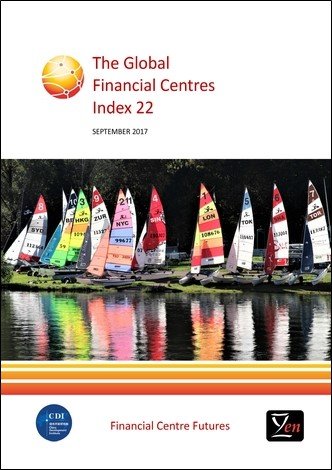Authors
Mark Yeandle
Published by
Long Finance & Financial Centre Futures (September 2017), 48 pages. Produced by Z/Yen in Partnership with CDI.
Share on social media:


You might also be interested in:
The Global Financial Centres Index 22
September 2017 saw publication of the 22nd edition of the Global Financial Centres Index (GFCI 22). GFCI 22 provides evaluations of future competitiveness and rankings for the major financial centres around the world. The GFCI continues to serve as a valuable reference for policy and investment decision-makers.
China Development Institute (CDI) in Shenzhen and Z/Yen in London collaborate in producing the GFCI. The GFCI is updated quarterly and published every March and September, and receives considerable attention from the global financial community.
106 financial centres were researched for GFCI 22. The index is compiled using 102 instrumental factors. These quantitative measures are provided by third parties including the World Bank, The Economist Intelligence Unit, the OECD and the United Nations.
The instrumental factors are combined with financial centre assessments provided by respondents to the GFCI online questionnaire (www.globalfinancialcentres.net). GFCI 22 uses 23,812 assessments from 3,159 respondents.
The Headlines of GFCI 22 include:
- There is an overall drop in confidence amongst the leading centres. Of the top 25 centres, 23 fell in the ratings and only two rose. At the lower end of the table, 20 of the 25 lowest rated centres actually rose in the GFCI ratings.
- Little change in the top five positions. London and New York remain in first and second places. Interestingly, despite the ongoing Brexit negotiations, London only fell two points, the smallest decline in the top ten centres. Hong Kong has moved just ahead of Singapore into third – only two points ahead on a scale of 1,000. Tokyo remains in fifth.
- The gap between third place Hong Kong and second place New York is now only 12 points. This is the smallest gap between second and third places for over five years. New York fell by 24 points, the largest fall in the top 15 centres, presumably due to fears over US trade.
- Western European financial centres are still volatile. Frankfurt, Dublin, Paris and Amsterdam all rose, but Zurich, Geneva, and Luxembourg fell in the ratings. Overall assessments for the European centres continued to fluctuate as people speculate about which centres might benefit from London leaving the EU. However, the majority of centres in the region rose with Stockholm, Copenhagen, and Vienna all showing strong rises.
- The leading financial centres in the Asia/Pacific region fell in the ratings. All of the top ten centres in the region fell in the ratings with Singapore, Tokyo, and Osaka all showing marked declines. These are reverses of strong gains made in 2015-16.
- All centres in North America fell in the GFCI ratings. As mentioned above, New York fell. San Francisco, Boston, Chicago, and Washington also saw large falls. The decline of Canadian centres was less severe than the falls of the USA centres.
- All of the Eastern European centres rose in the ratings. Cyprus, Athens, St Petersburg, and Moscow reversed some of their recent declines.
- Financial centres in the Middle East and Africa showed mixed results in GFCI 22. Dubai and Casablanca fell slightly, but other centres in the region did well. Abu Dhabi, second in the region, reduced the gap to first place Dubai to just nine points. Elsewhere in the Middle East, there were good rises for Bahrain and Riyadh.
- Latin American and Caribbean centres did well. The Caribbean centres of the British Virgin Islands and the Bahamas saw strong rises. Sao Paulo and Rio de Janeiro also did well. Buenos Aires joined the main GFCI, but Santiago remains an associate centre having failed to accumulate a sufficient number of assessments to enter the main index.
- European ‘island’ centres did well. The British Crown Dependencies of Jersey, Guernsey, and the Isle of Man all per-formed strongly and there were also strong rises for Malta, Reykjavik, and Gibraltar.




